|
COVER STORY | IN
THE NEWS | DIRT | ARTBEAT July 13, 2006
The man and woman had lived in these Southern Humboldt woods for 20 years. It wasn't a long time. Other people had roamed these tree-covered hills for thousands of years before them. But that age was past. Then, mere decades ago, loggers swept through and took many of the big redwoods and Douglas firs, leaving behind giant stumps as reminders of a different forest. Other trees — especially tan oaks — filled the spaces with their skinny offspring. They'd always been here, but now they flourished. Into this modern landscape came new people like the man and woman — people wanting to get away, burrow into the woods and live a nice, quiet life beneath the sun-filtering canopy with bears, flying squirrels and birds for company. Secretive people, you might say, in a secretive realm. The man and woman built a strong, pretty home, brought in decorative plants to nourish their complex human psyches, and over the years as they wandered lovingly over their hilly property, their feet trod narrow, winding paths through the leafy undergrowth: to that swimming hole in the rock-strewn creek below where horsetails poke up through heavy silt banks and willows gain purchase where they can; to that deep shady spot where a few big redwoods still stand; or to that particularly lush stand of shiny-leafed huckleberries (although, really, the huckleberries grow everywhere). Other people lived beside them in these woods — at a respectful, out-of-view distance. Everybody minded their own business — well, so we assume, although what stranger can truly divine the currents that run through a rural community? But it was, for the most part, a beautiful, peaceful life, braced by work and the usual seasonal battles with nature: intense heat in the summer, torrential rain in the winter, weeds, fires, floods. That broke up the monotony while affirming the hearty worth of a life built in the woods. And then, this past March, the man and woman learned that their world was about to drastically change. Doctors told the man he had cancer. And biologists told the couple that a disease had also invaded their woods. Both conditions would have to be dealt with immediately. The news has made the man quite apprehensive. "I looked out the window the other day and went, `Oh, man — what's that?!'" the man told a forest researcher from the University of California Cooperative Extension office in Eureka a couple weeks ago. They were wandering around the man's property, looking for signs of the pathogen Phytophthora ramorum, and the thin, tanned landowner kept looking up and around, sighing and shaking his Mark Twain-like head of shaggy white hair. Every tree has become suspect in the man's eyes: every branch showing a telltale wither and droop, every leaf looking dried or curled, every trunk oozing sap, even a large, graceful tan oak innocently putting forth new leaves that happen to start out brownish red before they mature to dusty green. "Ever since I found out I had cancer," the man said, "I'm thinking, `I'm going, and everything out there is going ....'"
The approach for dealing with his land's infected trees, and the healthy forest around them, is similar, but the prognosis for a cure less hopeful. The method that so far has proved the most effective against the pathogen that is killing them — and causing what is somewhat misleadingly called "sudden oak death" for the way people suddenly notice that a tree has gone completely brown — is cutting the infected trees, or trimming the infected branches and leaves, then burning them in situ so as not to transport the pathogen elsewhere. But as to whether that sacrifice will stop the spread of P. ramorum is anybody's guess. Already the pathogen has worked its way north from Marin and Santa Cruz counties, where scores of oak trees have succumbed to it since it was first discovered in the mid-1990s. The fear is it will continue its northward march.
The day that the forest researcher, Chris Lee, drove down to the Salmon Creek watershed to talk with the landowner whose woods are infected with P. ramorum, and to walk around and identify the individual victims, he wasn't sure just how widespread the infection would turn out to be. The day was hot, sunny. The Eel River sparkled, and along the sides of Highway 101 numerous flowers and shrubs, many of them considered weeds, bloomed pink, yellow and orange and cast a sugary spell on anyone who dared to enjoy them. Once within the Salmon Creek watershed, Lee eventually took a side road and wound along it until he reached the landowner's house. For more than an hour they walked around, going tree by tree, looking for signs. The landowner worried about one tree, close to his house, with a brownish gash low on its trunk. "Now what about this right here?" he asked Lee. "Did you prune it?" asked Lee, a slim young man with a faint Arkansas accent, gray-green eyes and hair that has prematurely grayed.
Lee told him it didn't really look like P. ramorum at work on that tree. Certainly the symptoms of the pathogen resemble those caused by many other infections, he said — to identify P. ramorum definitively, a sample has to be sent to a lab. But even so, this tree's wound didn't show any of the telltale signs. They walked on to the next tree. And the next. So far, so good. "See, what's that, those brown leaves?" the man said, suddenly, pointing at a big tan oak. Lee looked at the leaves, noting they weren't spotted, nor dried, thickened and curled at their edges as if someone had dipped them in a thin lacquer. "Looks like it may be new leaves," he said. They walked on. Right: SoHum landowner (L) and forest researcher Chris Lee (R) look for infected trees. Downslope from the house, they came across a tree that did show evidence of possible P. ramorum infection. "Those are classic symptoms," Lee said. The tree — a tan oak — had rust-colored bleeding spots up and down its trunk. "Tan oak is a weird thing. It hosts Phytophthora ramorum on its leaves and it gets an infected trunk." Every tree species — and there are more than a hundred now known to be susceptible to P. ramorum — reacts differently to the pathogen. Some, like redwoods, seem to only get infected on their twigs (and don't die from it). Others get it all over. It kills tan oaks — once it's in the trunk, it works its way around in a circular pattern, the bleeding cankers it produces "girdling" the trunk and cutting off the flow of nutrients. Infected leaves may start out spotted, then turn a light tan, harden and curl; an infected twig and its leaves will droop, looking like a "shepherd's crook." The landowner, despair in his voice, looked uphill at a vast thicket of "pencil" (thin) tan oaks and said, "I mean, look at this." Walking downslope farther, into a stand of redwoods and Douglas firs where there were fewer tan oaks, they kept searching. Ravens, crawking in the sunshine as they flew above the tree tops, cast shadows that floated through the dappled understory. "Most of these trees are looking pretty good," Lee said, encouragingly. "I think it's in the early stages here." Closer to the creek, Lee stopped. "This is the tree you need to worry about," he said. "The pepperwood bay. They harbor the pathogen on their leaves and pass it on prolifically to other trees. See the brown tips?" And there more were suspect pepperwoods — also known as California bay laurels and, in Oregon, myrtlewoods. "So," said the landowner, continuing his tally, "we've got this one to take out. And that one." And there were more. "Yeah, this is kind of sad," said Lee as they walked along the creek, upstream, passing willow stands with wads of dead grass and limp twigs wrapped high in their branches, evidence of high water. "It's more than I thought there would be, which is usually the way these things turn out." But the bigger trees were OK, suggesting the infection here was in the early stages. The maples, hazels and cottonwoods also seemed clean. Within one healthy tan oak, where Lee had pulled back a branch to inspect the leaves, they discovered a tiny cuplike nest, its outside plastered with flakes of camouflaging bark, its inside stuffed with two hungry baby hummingbirds. This was still an alive forest, despite P. ramorum's apparent deathgrip.
"Every time the wind blows, I think, `Ohhh!'" said the landowner. "But it's only in the winter, when it's moist, that you really have to worry about that," Lee reminded him. P. ramorum loves moisture, which is why, researchers say, it seems to have followed a path up the coast through the redwood band. Here, in these Southern Humboldt mountains, perhaps summer's intense, dry heat would offer a reprieve for landowners trying to get a jump on the problem. It also meant people driving around on the dusty backroads and hiking in the woods, where in the winter they're more likely to pick up spore-filled mud in their treads, wouldn't be spreading the pathogen as readily. Tackling the already doomed or infected trees right away wasn't a bad idea. "Let's go look at that one," said Lee, and they doubled back through a thicket of undergrowth. "Oh, now, here's a live oak. It's got the wilty tips, it's drying out." They walked on, stopped again. "Yep, that pepperwood, and that one. And all of those." "Well, you're just a pile of joy," said the landowner.
Phytophthora ramorum was first discovered in Southern Humboldt County in 2002 at a spot near Redway — seven years after its appearance was first noted in the United States in Marin and Santa Cruz counties. It showed up in the country at nurseries, at first, particularly on camellias, rhododendrons and similar plants. Occurrences of P. ramorum on the east coast and elsewhere in the country were soon traced back to one genetic line — they were all clones, in other words, of one organism — which suggested the pathogen had come over to the country as one individual, said Lee. The fact the pathogen hadn't diversified meant it must be a new arrival.
"This sometimes makes it hard to move products," Lee said. "For instance, to cut firewood in Orleans and try to carry it a short distance into Siskiyou County, or for Simpson Timber Co. to export tan oak out of the county for pulp, or as wood chips — it can be done, but it requires extra regulatory procedures." Left: Chris Lee At first the pathogen was poorly understood. It seemed like a fungus, growing hyphae and producing spores. "But its spores are different, they have flagella," said Lee. "So a lot of people call Phytophthora ramorum `water molds.'" Scientists eventually decided the pathogen belonged in the kingdom of organisms that includes kelps and diatoms, but that it was very different even from them. What they did know was that it was related to a number of other species in the genus Phytophthora that have wreaked havoc on the plant (and human) world: One species causes root rot in Port Orford cedars in the Klamath-Trinity region; another caused the potato famine in Ireland; and yet another is killing eucalyptus trees in Australia; and the same species, but a different strain, of ramorum has scientists in the United Kingdom running ragged as well. "Phytophthora ramorum is one of the few that doesn't attack the roots," said Lee. "It is primarily airborne, and attacks trunks, leaves and twigs. It only reproduces when it infects the leaves." It can reproduce sexually — with another strain — and asexually, by spore production. So far, it appears to have only reproduced asexually in this country; scientists fear what may happen if different strains should meet and reproduce sexually, creating yet more strains of the pathogen. The pathogen has killed more than a million wildland trees, said Katie Palmieri, public information officer for U.C. Berkeley's Center for Forestry, on Monday. Most of these have been tan oak (not a true oak), and a number of oak tree species including California black oak and coast live oak. "We've spent $70 million to date nationwide" combating P. ramorum, Palmieri said. In 2004, more than a million infected nursery plants had to be destroyed. Most of them had been inadvertently distributed from one nursery in Southern California, and that nursery alone has suffered $5.5 million in losses. In Humboldt County, the attack against P. ramorum has involved a collaboration between the Southern Humboldt Fire Safe Council/Institute for Sustainable Forestry, the California Department of Forestry, Caltrans, Humboldt County's agriculture department (which inspects the nurseries), the U.C. Cooperative Extension, California State Parks, individual private landowners and others. In the state park, they've been testing different treatments for stopping the pathogen, cutting some infected stands of trees and burning the piles; cutting others and not burning. On a tiny scale, said Lee, there's even been some success with injecting individual trees with phosphonates, which attack the pathogen. But that isn't practical on a widespread scale. "Next we are going to start some trials with large-scale spraying" of phosphonates, Lee said. Still, it isn't certain they'll truly be able to stop the spread of P. ramorum, says Hugh Scanlon, vegetation management coordinator with the CDF, who has helped coordinate an assault on infected trees in Humboldt Redwoods State Park around the Jay Smith Road area. There, they've been cutting infected California bay laurels and tan oaks. "In the state parks, tan oak is a very important mid-story habitat for the northern spotted owl," Scanlon said. "It also can be a factor for murrelet habitat. So, we have concerns about the effect [of cutting the trees down]. On the other hand, we expect the infected tan oak to die anyway, so there's just a couple of year's difference in when that happens." The vast infection at the Jay Smith site has been difficult to combat, he said. "Last winter we were treating 50 acres, cutting tan oak and bay and burning piles," Scanlon said. "We had committed over 70 crew days, and we had 45 acres done, before we had to stop for the nesting season. So, we threw a lot of resources at that site to control that pathogen, and we were not able to keep up with it. It was moving too fast. And there are now tentative new sites north of that area."
Bertoni's report blamed lapsed vigilance at ports of entry for the pests' ability to enter the country, as well as a failure on the part of the USDA to adequately inform the public on the infestations and how to deal with them. P. ramorum alone, Bertoni said, "has affected more than 19,000 square miles in California and one county in southwestern Oregon. Together, according to USDA, these [three] forest pests have the potential to cause the loss of trees valued at trillions of dollars." At this point, considering all the money thrown after a likely-to-get-away pest, one has to wonder if the effort is even worth it. Sure, go ahead and spray Lysol on your boots (apple scent is the nicest, Lee and his colleagues have discovered) after you've been in an infested area. Wash your car tires in a bleach solution during the muddy season. It's the least one can do, as an individual. But try and stop the wind.
Right: Forest researchers August Deshais (L) and Chris Lee (R). Lee agreed that he and the other people in the multi-agency effort to find and destroy P. ramorum do have a tough job ahead. Just recently, he had pulled some of his "bait traps" from Elk Creek. These are little mesh bags with leaves in them that Lee floats in the waterways from a string — if P. ramorum spores are in that river or creek, they will attach to the leaves. And that, in turn, tells Lee if that watershed is infested. The bait trap leaves he'd set in Elk Creek tested positive for the spores, he said, "which is a shame." As for letting it just go? "I think it comes down to, what do we want to see when we look out on the landscape?" Lee said. "Change? Because these things do cause change. And humans have always changed the landscape; it's just that we're doing it now on such a grand scale." As the CDF's Scanlon described it, on another day, people should brace themselves. "Sudden oak death presents a major challenge, because it's going to start causing a major change in the forest structure itself, and then in the species composition of that structure," Scanlon said. The one thing we can hope for, he said, was that perhaps a regime of fire treatment would prove effective in slowing the pathogen's spread. That, and the inevitability that some tan oaks and other trees will likely prove resistant to the pathogen, and their sprouts will emerge to repopulate the woods. Monroe, contacted a week after his chat with Lee in Myers Flat, reflected again on the pathogen — and on human nature. "I'm combating bindweed in my garden right now," he said. Bindweed is a wild morning glory with delicate white flowers. "It climbs all over and smothers everything. I couldn't get to my boysenberry bushes this morning because of it." But sudden oak death — that's huge, he said. "The way it has spread — it's like we're something small, standing in the wind, and it blows right by. Those spores are so tiny." Monroe came to Humboldt County in 1971 to get a
biology degree at Humboldt State University. In the summers,
he worked with logging crews. "I saw most of the big old-growth
redwoods go down. So I know that the forest has changed in the
non-park areas, much to my chagrin. It really bothered me. We
would go into a pristine forest and, when we were done, every
square foot of ground was plowed over, and it was all stumps.
Then the rain would come and it'd look like World War III. I
didn't feel good about it. I'm a lover of nature." He said
he watches the news, learns about weeds and species loss and
other terrible events, and feels stuck. "It's tough, we're
locked into a lifestyle. Here I have a gas-eating vehicle, but
I need it. I don't like it, but here I am doing it. I didn't
like logging, but I had to do it for the money." Right: Leaves showing the tell-tale signs of infection.
The week after he had walked around with the forest researcher from the U.C. Cooperative Extension office, the landowner whose land was infected hired a bunch of friends to start cutting down his afflicted trees. For him there was no question about taking on the infection. And while his friends cut his trees, he made a foray to the city for the first of his cancer treatments. By the end of the week he was back at home and a quarter of his tan oaks and pepperwoods had been cut and brushed into piles, to be burned in the winter. "We took out those ones down by the creek," he said last week on the telephone. "Bay laurels and tan oaks, dozens or more." It has cost him and wife $2,390 from their savings so far. There could be more to do. Perhaps, he said, there will be grants available for future cutting — their money could run out, and some of their neighbors don't have savings to dip into. Chris Lee, the U.C. forest researcher, had told him to check with the CDF about that, and had said more help could be coming down the pike from other agencies. In the meantime, the landowner said, he'll be keeping
watch on his remaining forest. Actually, his land is faring better
than some of his neighbors' properties so far . "My nearest
neighbor came down the other day, and she said, `I've got totally
dead t Worse, if they don't get all of the infected trees cleared, their woods will be loaded with ready fuel and fires could sweep through with especial ferocity. But in the end, fire — and cutting — could have a beneficial outcome, as long as not all trees are lost. The landowner admits he enjoys a certain pleasing, aesthetic effect that comes with a drier, more open forest. Still, he said, the task of achieving that effect, and creating a healthy forest, "isn't fun." Nor is the suddenness with which the disease that precipitated all the frantic activity descended. Nobody's ever prepared for that sort of blindsiding, he said. Like with his cancer, for instance. "Everybody kind of goes along with their life, thinking everything's OK, and then all of a sudden there's all these hidden things," the man said. "And, omigosh, my world falls apart in seconds."
COVER
STORY | IN
THE NEWS | DIRT | ARTBEAT Comments? Write a letter! © Copyright 2006, North Coast Journal, Inc. |

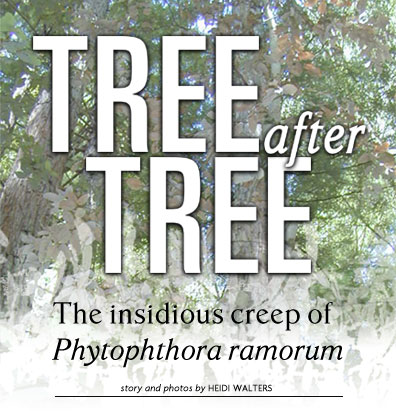
 Thankfully
for the landowner — who asked that his and his wife's
names not be used in this story — the prognosis for curing
his particular cancer, stopping its spread to the rest of his
body, is generally hopeful. Doctors have already put him through
a preliminary treatment, and next they will inject tiny radiation
beads into the afflicted part of his body. The beads will selectively
attack the cancerous mass — a less-invasive technique than
traditional radiation that must pass through good flesh to get
at the bad.
Thankfully
for the landowner — who asked that his and his wife's
names not be used in this story — the prognosis for curing
his particular cancer, stopping its spread to the rest of his
body, is generally hopeful. Doctors have already put him through
a preliminary treatment, and next they will inject tiny radiation
beads into the afflicted part of his body. The beads will selectively
attack the cancerous mass — a less-invasive technique than
traditional radiation that must pass through good flesh to get
at the bad.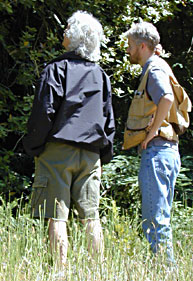 "Yeah,
at one point," the landowner said.
"Yeah,
at one point," the landowner said.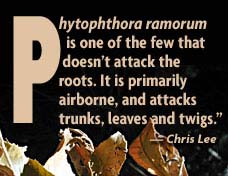 They
walked back up the hill, along a winding path dancing with poison
oak and fragrant pennyroyal and flanked by an occasional, healthy,
red-trunked madrone tree. The landowner told Lee that he intended
to deal with the infected tan oaks and bays immediately. Why,
he'd actually been meaning to thin out those pencil tan oaks
for the last 20 years, just never got around to it. It would
open up the forest a bit, get some light in there and maybe give
the Doug firs and redwoods a chance to re-establish a presence.
He wanted to hurry and get started — P. ramorum's
spores are readily transfered on the wind, which means yesterday
was too late to start battling it, to his way of thinking.
They
walked back up the hill, along a winding path dancing with poison
oak and fragrant pennyroyal and flanked by an occasional, healthy,
red-trunked madrone tree. The landowner told Lee that he intended
to deal with the infected tan oaks and bays immediately. Why,
he'd actually been meaning to thin out those pencil tan oaks
for the last 20 years, just never got around to it. It would
open up the forest a bit, get some light in there and maybe give
the Doug firs and redwoods a chance to re-establish a presence.
He wanted to hurry and get started — P. ramorum's
spores are readily transfered on the wind, which means yesterday
was too late to start battling it, to his way of thinking.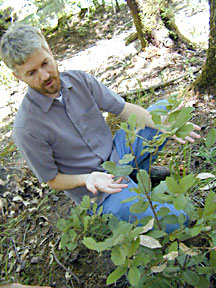 U.C.
Berkeley researchers think the pathogen came from western China,
and may have come to this country via nurseries, said Lee. Ever
since its discovery, nurseries have had to undergo strict monitoring.
Quarantines have been placed, in some years, on states whose
nurseries have shown signs of the disease, and on timber products
from infected areas. In Humboldt, the infection still is centered
around the Redway area, but the whole county is quarantined even
though it's just on the edge of the pathogen's territory.
U.C.
Berkeley researchers think the pathogen came from western China,
and may have come to this country via nurseries, said Lee. Ever
since its discovery, nurseries have had to undergo strict monitoring.
Quarantines have been placed, in some years, on states whose
nurseries have shown signs of the disease, and on timber products
from infected areas. In Humboldt, the infection still is centered
around the Redway area, but the whole county is quarantined even
though it's just on the edge of the pathogen's territory. On
June 21, Daniel Bertoni, acting director of Natural Resources
and Environment within the United States Government Accountability
Office, testified before the House Subcommittee on Forests and
Forest Health. His report was called Invasive Forest Pests: Recent
Infestations and Continued Vulnerabilities at Ports of Entry
Place U.S. Forests at Risk. The GAO report looked specifically
at three pests: the Asian longhorned beetle, which the GAO determined
would indeed be eradicated from the states it had infested; and
the emerald ash borer and Phytophthora ramorum —
and those two, the GAO report said, were "likely to continue
to infest and damage forest ecosystems in the Midwest and on
the West Coast, despite efforts to control them."
On
June 21, Daniel Bertoni, acting director of Natural Resources
and Environment within the United States Government Accountability
Office, testified before the House Subcommittee on Forests and
Forest Health. His report was called Invasive Forest Pests: Recent
Infestations and Continued Vulnerabilities at Ports of Entry
Place U.S. Forests at Risk. The GAO report looked specifically
at three pests: the Asian longhorned beetle, which the GAO determined
would indeed be eradicated from the states it had infested; and
the emerald ash borer and Phytophthora ramorum —
and those two, the GAO report said, were "likely to continue
to infest and damage forest ecosystems in the Midwest and on
the West Coast, despite efforts to control them."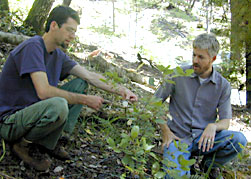 After
his meeting with the landowner that day, Chris Lee drove
down to Myers Flat to meet up with August Deshais, who was hired
to comb the woods for him this summer to look for more signs
of Phytophthora ramorum. While waiting for Deshais, Lee
ran into furniture builder George Monroe outside his shop. Monroe,
the fire chief for the Myers Flat volunteer fire department,
shook his head after Lee told him about his day. "I dunno,
you have a tough job," Monroe said. "I don't see how
you can do it. It might have to run its course."
After
his meeting with the landowner that day, Chris Lee drove
down to Myers Flat to meet up with August Deshais, who was hired
to comb the woods for him this summer to look for more signs
of Phytophthora ramorum. While waiting for Deshais, Lee
ran into furniture builder George Monroe outside his shop. Monroe,
the fire chief for the Myers Flat volunteer fire department,
shook his head after Lee told him about his day. "I dunno,
you have a tough job," Monroe said. "I don't see how
you can do it. It might have to run its course."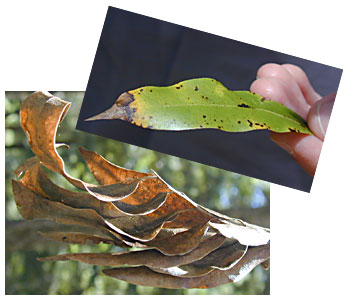
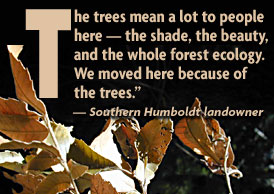 rees,'"
the man said. "And the guy above me has already been cutting
trees. His trees were all brown and dead. He has one huge, magnificent
tan oak, and he's afraid he might have to take it down. It's
very devastating. The trees mean a lot to people here —
the shade, the beauty, and the whole forest ecology. We moved
here because of the trees."
rees,'"
the man said. "And the guy above me has already been cutting
trees. His trees were all brown and dead. He has one huge, magnificent
tan oak, and he's afraid he might have to take it down. It's
very devastating. The trees mean a lot to people here —
the shade, the beauty, and the whole forest ecology. We moved
here because of the trees."